Feature Article, February 2003
The following excellent article appeared in
the Summer 2002 AFTE Journal. A large number of sound files were recorded
during the course of the tests conducted by the author which should be of great
interest to AFTE members and other firearm enthusiasts. Four sound
files referenced to in the article can be heard by clicking the "speaker"
graphic next to Figures 2-5. All photos and figures in the article below
are thumbnails which can be clicked on to view these files in a larger format. Additionally several other "sounds of
bullets" audio files that readers may find interesting are linked to at the
bottom of this article.
Note: A multimedia enabled PC is required
to play the sound files. Also, the audio files range in size of between
200 and 600k. Download times will vary according to your internet
connection speed.
The Sound of Bullets
by Lucien C. Haag, Forensic Science Services
AFTE Journal #34, Summer 2002, Page
255
Copyright©2002-2003 Lucien C. Haag. All rights reserved.
Reprinted here with permission of the author.
Key Words: bullets, sound, supersonic, subsonic, mach cone, lagtime,
exterior ballistics
ABSTRACT
Firsthand observations and instrumental recordings reveal that even small
caliber projectiles such as .177 caliber pellets at relative low velocities
(e.g.- 350f/s) produce audible sounds as they pass an observer's location so
long as the distance from the responsible gun is sufficient that the sound of
the projectile's passage is not masked by that of the discharge of the gun. This
requirement, and the ability to produce audible sounds at downrange locations,
is also true for larger and more powerful guns. Bullets that are supersonic as
they pass a downrange subject produce a loud, sharp `crack' that can only be
heard after the bullet passes the listener's position. This sound is similar to
the sharp `crack' produced by a bullwhip and it is exactly for the same reason-
the tip of the bullwhip has gone supersonic. Subsonic bullets, on the other hand
can often be heard as they approach, pass by and depart a subject's location.
These sounds are quite different in character and intensity. These bullets
frequently produce a hissing sound and are much less intense that the loud
`crack' of a supersonic bullet. In cases where an audio recording has captured
both the sound of the bullet at some downrange location and the distant report
of the responsible gun, it may be possible to calculate the distance from which
the shot was fired from the time differential between the two sounds.
In May 1991 the author presented an argument at the Spring California
Association of Criminalists Seminar that light and sound were forms of physical
evidence. The sound and muzzle flash produced by firearms during discharge were
used w illustrate this proposition. Many years prior to this (1979) a basic
inquiry was made into the acoustical spectra of recorded gunshots. In the years
that have followed, recurring questions have been posed to this writer regarding
the existence of audible sound produced by the passage of bullets near to
subjects located various distances downrange of a gunshot. Some witnesses and
purported victims have claimed to hear a bullet pass by them and this writer has
been asked on a number of occasions to evaluate the merits of such claims. These
subjective accounts led to this research project.
Long distance shooting incidents may range from perhaps 100
yards to as much as a mile. In these situations a variety of interesting
questions may arise. It a bullet passes near a downrange listener. can it be
heard? If so, what sort of sound would it make? How loud are these sounds? Does
the shape and/or design of the bullet influence the properties of the sound it
produces? Does a ricocheted bullet sound differently from a 'normal' bullet?
Does velocity play a role in sound production said character? Can such evidence
be evaluated in some objective manner?
The work carried out by this writer has shown that when the time
interval between the arrival of the sound of the shot and the arrival or passage
of the bullet at a downrange location is sufficiently separated (approximately
0.25 seconds or greater), it may be possible to hear the bullet's passage or
arrival. This is contingent on a number of factors beyond the general
sensitivity of the listener's hearing. The level of ambient noise, the loudness
of the bullet and the proximity of the bullet to the potential listener are
obvious parameters of importance.
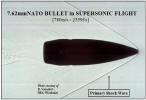
Photo #1: A shadowgraph of a 7.62NATO bullet at Mach 2.3. The
primary shock wave (Mach cone) forms a nominal 60° angle at this velocity. A
secondary shock wave can be seen coining from the cannelure. Turbulence in the
air behind the bullet can also be seen.
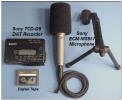
Photo #2A: The digital recording equipment
used to record the sounds of bullets and the distant report of the guns that
fired them at selected downrange locations.
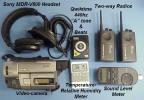
Photo #2B: The a n c i l l a r y equipment used in recording
bullet sounds and in standardizing the procedure and annotating the results.
Investigators in such cases typically fail to ask a number of important
questions and this compromises most laboratory input. Did the sound of the
bullet or the sound of the shot reach the witness first? What was the time
differential between the two? What sort of sound did the. bullet make? Insofar
as the firearm examiner is concerned, additional questions should come to
mind. Would the bullet be subsonic or supersonic when it arrived at the victim's
location? Would it even be possible to hear a bullet of the particular type as
it passed by? If so, how loud would it be and what would it sound like? The
research described in this article will answer most of these questions.
A variety of firearms and ammunition types were evaluated in this 3-year study.
These ranged from .177 caliber pellets tired from a Model 46 RWS pneumatic rifle
tired from a range of 80 yards to a number of high and medium velocity rifles
fired at ranges extending out to 1100 and 1500 yards. A variety of 9tnm
handgun bullets of varying shapes and weights were also studied out to a range
of 1100 yards. The various pellets and bullets used in this 3-year study are
shown in Photos #3 - 9. As can he seen from these photographs, a variety of nose
shapes, meplat diameters, base shapes, bullet weights, cannelure arrangements
and styles were selected. Initial evaluations were carried out by simply placing
listeners in protected downrange locations and firing projectiles from a number
of these guns past the listeners'
location at distances ranging from a few feet to a few yards.

Photo #3A: Two views o€ the various shapes and weights of .177
caliber RWS pellets used to evaluate the production of sound by smaller caliber,
low velocity projectiles.
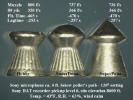
Photo #3B: Three .177 caliber RWS pellets that produced audible
sounds at 80 yards and with downrange velocities of approximately 360 f/s.
The author's first formal experience in this regard occurred
during his work on a historical long range shot made on June 27, 1874 at Adobe
Walls, Texas. [Note: readers interested in this remarkable event should read
Ruprecht Nennstiel's article in the July 1995 issue of the AFTE Journal]
The original shooter was Billy Dixon and the gun was a "Big 50" Sharps. This
writer went to the actual location (if this historic long shot and positioned
himself in a protected area very near the site where the unlucky Indian
sustained his fatal injury from Billy Dixon's 1538 yard shot. As a result of
Ruprecht Nennstiel's computations and some actual firings at the Yuma Proving
Grounds with the author's .50 Sharps, Mike Haag was able to deliver three
successive .50 caliber 438 gr. lead bullets to the same small mesa on which the
Indian was killed. He fired each of these from the actual site of Adobe
Walls-still recognizable after the passage of more than 120 years. The sound of
each of these approaching bullets could easily be heard about 2.5 seconds after
the arrival of the distant sound of the shot. The total flight time of these
bullets was about 6.5 seconds. These bullets produced a z-z-z-z-z-z sound with a
Doppler shift as they approached and passed by this writer's position. The time
interval between the arrival of the bullet and the arrival of the sound of the
shot was in good agreement with the calculated value. The author has chosen the
term "lagtime" for this phenomenon. A more detailed description of lagtime will
be given later in this article. Figure 6 shows a plot of Lagtime in seconds vs.
Distance in yards for a 425 gr. .50 Sharps bullet with a G1 ballistic
coefficient of 0.20 discharged with a muzzle velocity of 1475 f/s. This should
provide the reader with a graphic illustration of the concept and potential
value of lagtime.
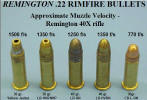
Photo #4: The lineup of .22 rimfire bullets fired out to 500 yards. All of these
bullets produced a hissing sound when subsonic and sufficiently downrange to he
distinguished from the report of the rifle.
Several years later and at the other ballistic extreme, .177
caliber pellets of various nose shapes were tired from a single stroke RWS air
rifle. The chosen range was 80 yards. The muzzle velocities of the pellets shown
in Photo #3 were on the order of 750f/s. and their downrange velocities at 80
yards had all fallen to about 3507s. Under these conditions, the lagtime for the
arrival of the pellets was nominally 0.25 seconds- adequate for them to be
heard after the distant sound of the discharge of the air rifle. All of these
small, low velocity projectiles could be heard passing within 3 to 6 feet of the
listener's location immediately after the arrival of the sound of the discharge
of the air rifle. These pellets produced a very brief hissing sound as they
passed the 80 yard listening and recording station. A number of these were also
recorded with the special recording system consisting of a Sony TCD-D8 digital
audio tape recorder and a Sony ECMMS957 Electret condenser microphone. Ancillary
equipment consisted of a Sony MDR-V600 headset, a Quicktime digital metronome
and 440 Hz tone generator, a Sony Hi-8 video camera, a pair of portable 2-way
radios, a digital temperature-relative humidity detector and a sound level
meter. The equipment used in this study is shown in Photo #2A and 2B.
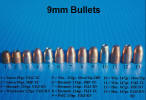
Photo #5: The lineup of 9mm ,jacketed pistol bullets of varying weights and
designs. Many of these were fired out to 1100 yards with a 9mm carbine where
they had residual velocities on the order of 500 f/s and produced very audible
sounds as they passed over downrange observers.
This equipment was used to reduce the numerous auditory
observations to an improved and more objective form. The microphone was
positioned so that the bullets passed within a few feet or yards of the
microphone. A protective arrangement was employed so that any short round could
not damage the recording equipment yet fired bullets could pass over the
microphone at relatively close and known heights. This was accomplished by
sighting in the particular rifle [often equipped with a telescopic sight] on a
paper bullseye target immediately adjacent to the recording system. To avoid the
sound of the bullet striking the paper target, the recording equipment was
offset a few feet to the side of the paper target as was the sight picture for
the sound recorded shots. Open ground beyond the recording system was also
provided so that the final impact of the fired projectile was not coincident
with the bullet's passage over the microphone. A standard 440 Hz tone and 100
beats per minute pulse were recorded on each digital tape prior to and
subsequent to each recording session. The 440 Hz tone was produced at a fixed
distance from the microphone and at a measured decibel level. An example of this
audio-standardization technique is depicted in the Sound Forge spectrum shown in
Figure 1. The recorded sounds of sub- and supersonic bullets as well as the
distant gunshots were examined with the Sound Forge program. Examples of these
acoustical spectra are appended to this article as Figures 2 - 5. This program
is useful in accurately measuring the time interval between the sound of the
shot and the sound of the bullet's passage from audio recordings. It also
provides some insight into the intensity of these sounds. In a few instances the
portable radios were used to transmit the sound of the particular gun's
discharge to the downrange location. This allowed for a critical measurement of
the time required for the sound of the shot to reach the downrange microphone.
An example of this technique is shown in Figure 2.
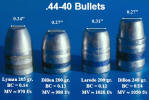
Photo #6: The lineup of .44 caliber cast lead bullets of similar weights and
designs. These were fired out to 1100 yards where they had residual velocities
on the order of 300 to 400 f/s. All of these bullets produced very audible sounds
as they approached and passed over downrange observers. (See the Figure 4 Sound
Forge spectrum of one of these shots)
A number of long distance shots ranging from 500 yards to 1100
yards were also videotaped using a special mirroring system to protect the
downrange video camera. The camera was focused on the gun so that it's discharge
could be documented followed by the audio recording of the gun's report and the
bullet's passage over the camera's position. This was especially useful with
black powder cartridges and smokeless powder cartridges to which a small amount
of black powder was added to produce a visible puff of smoke at the instant of
discharge. A viewing of this tape provides a very useful example of the concept
of lagtime since the discharge can be seen followed by the separated sounds of
the shot and the bullet's passage over the video camera.
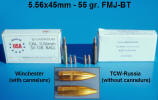
Photo #7: Cannelured and uncannelured 5.56x45mm bullets fired out to 1100 yards.
The supersonic 'cracks' were quite loud and followed by additional sound. At
this distance (heir residual velocity was ca. 1200 f/s.
The author defines 'Lagtime' as the difference between the time
of arrival of the sound [SAT] of the shot minus the time required for the bullet
to cover the distance from the gun to the same down range location [BAT] or
T.O.F. (time of flight). This can be reduced to a simple formula:
SAT -
BAT = Lagtime.
If the bullet arrives first. the sign is + (because the bullet required less
time to cover the distance between the gun and the listener than that for the
arrival of the sound of the shot) . The sign will he negative if the sound of
the shot arrived first followed by the sound of the bullet's passage. This was
the situation for Billy Dixon's 1538 yard shot with his .50 Sharps even though the bullet was initially supersonic, it quickly became
subsonic and after about 150 yards of flight, the sound of the shot overtook the
bullet at about 325 yards and forged ahead of it as the bullet continued to
lose. velocity.
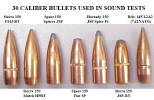
Photo #8: The primary lineup of .30 caliber
rifle bullets of similar weights and varied designs. These bullets were chosen
on the basis of various nose and base shapes. The supersonic 'cracks' of these
bullets were recorded at various downrange distances.
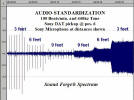
Figure 1: A Sound Forge spectrum depicting the 100 beat per
minute generator and the 440 Hz "A" tone generator recorded at three distances from the
microphone. Such a recording was placed at the beginning and end of each
recording session.
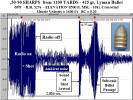

Figure 2. A Sound Forge spectrum depicting an 1100 yard, .50 Sharps shot with an
initial radio transmission of the discharge (producing a large squelch). The
radio was turned off immediately after this shot so the arrival of the sound of
the shot followed by the arrival of the 425 gr. bullet could be recorded.
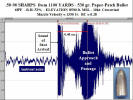

Figure 3: A Sound Forge spectrum depicting an 1100 yard. .50 Sharps shot
without any initial radio transmission of the discharge. The distant sound of
the shot is shown well above the ambient noise followed by the arrival of the
smooth, pointed 530 gr. bullet.
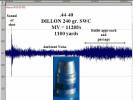

Figure 4. A Sound Forge spectrum depicting an 1100 yard,
.44-40 shot with the 240 gr. semi-wadcutter bullet at an estimated velocity of 475
f/s. The distant
sound of the shot it shown well above the ambient noise followed by the approach
and passage of this bullet.
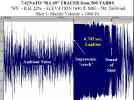

Figure 5: A Sound Forge spectrum of a .30-'06 tracer round fired from u distance
of 500 yards. The near-instantaneous rise of the supersonic shock wave appears
first followed 0.705 seconds later by the distant sound of the shot partially
buried in the diminishing noise of the departing bullet.
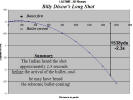
Figure 6: A graphic representation of "lagtime" using a
supersonic discharge of a .50 Sharps round fired out to a distance of 1600 yards. The bullet is
initially ahead of the sound or the rifle until ca. 350 yards where sound
overtakes it. The sound of the shut continues to outdistance the bullet as the
projectile continues to Wise velocity.
For any efforts to estimate range of fire from such a recording,
it will be necessary to obtain the site elevation and the meteorological
conditions a the time (temperature. relative humidity, barometric pressure, wind
speed and direction). This information is needed to refine estimates for the
speed of sound and for use in any exterior ballistic computations. Of these
parameters, site elevation is probably the most important since it has the
greatest impact oil the speed of sound. Table 1 provides data for the speed of
sound under various conditions and was derived from the Handbook of Chemistry
and Physics.
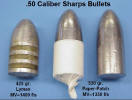
Photo #9: The two types of bullets available in 1874 for the .50 Sharps Buffalo
Rifle. Both bullets produce very audible sounds as they approach and pass by a
listener at 1100 yards to 1600 yards downrange. (Figures 2 - 3 show 1100 yard
Sound Forge Spectra for these bullets)
Table 2 provides exterior ballistic data from one of the 1995
Yuma Proving Grounds Doppler radar tracks of one of the .44 caliber bullets used
in this study. The downrange velocity and time of flight values are from the
Doppler data whereas the time for the sound of the shot to cover the same
distance was calculated by the author. This type of data was useful in comparing
the lagtime values obtained from the digital tape recordings of long distance
firings with the same bullet at comparable muzzle velocities. Table 3
illustrates the calculated exterior ballistic data for the .50 Sharps and serves
as the basis for the graph shown in Figure 6. As with many other shots
carried out during this study, the calculated lagtime was in good agreement with
the
actual, on-site experience.
The sound produced by bullets that were still supersonic at the
particular downrange location were readily
recognizable as such by the loud, sharp `crack' they produced. Photo #1 is a
spark photograph of a 7.62NATO bullet traveling at a velocity of 780 m/s (2559
f/s). This shadowgraph, provided by friend and colleague Ruprecht Nennstiel in
Germany, shows the clear, sharp Mach cone emanated from the nose of the bullet.
When one realizes that it is the arrival of this shock wave at ones ear that
results in the hearing of the bullet's passage, it should become apparent that
such a bullet has already passed the listener's location by the time it is
heard. Such a bullet cannot be heard as it approaches an individual, Much
subtler and subdued sounds will typically follow the supersonic shockwave due to
the atmospheric turbulence generated by the bullet's passage through the air. An
examination of Figure 5 showing the Sound Forge spectrum of a supersonic
bullet's passage over the microphone is useful in this regard.
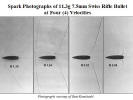
Photo #10: These four photos show the substantial changes in the
shock ware and turbulence patterns for the same bullet at different velocities.
The "M" stands for Mach and the numerical value represents the velocity of the
bullet relative to the speed of sound at the time of the shot.
A considerable variety of subsonic bullets and projectiles were
observed to produce audible sounds. These projectiles ranged from .177 caliber
pellets as the smallest in caliber and free-falling 00-buckshot (from vertical
firings) as the slowest. These .33 caliber spheres can be heard returning to
earth after a nominal 19 second round trip flight time following the vertical
discharge of a 12 gauge 00-buckshot shell. Their terminal free-fall velocity is
about 160f/s. Such returning pellets are especially audible when unbuffered
shells are employed. This is due to the numerous irregular indentations in their
surface acquired during the discharge process. Larger and faster subsonic
projectiles also produce audible sounds with those bullets that have blunt noses
and/or sharp corners.
TABLE 1
VELOCITY of SOUND in AIR
Data derived from the Handbook of Chemistry and
Physics, 66th Ed. (1985)
General
The speed of sound decreases with increased altitude
It increases with increased relative humidity and increased temperature
|
Dry Air at Sea Level-Variation
with Temperature |
Variation with RH at 20'C (68'F) |
| |
|
|
|
|
|
|
0°C
|
331.4 m/s
|
(1087 f/s)
|
10% RH
|
343 m/s
|
(1127 f/s)
|
|
10°C
|
337.5 m/s
|
(1107 f/s)
|
20% RH
|
344 m/s
|
(1128 f/s)
|
|
20°C
|
343.4 m/s
|
(1127 f/s)
|
40% RH
|
344 m/s
|
(1128 f/s)
|
|
30°C |
349.2 m/s |
(1146 f/s) |
60% RH |
344 m/s |
(1129 f/s) |
|
|
|
|
80% RH
|
344 m/s
|
(1130 f/s)
|
Variation with Altitude
|
Altitude (in)
|
Temperature (C)
|
Pressure (mb)
|
Gravitational Acc. (m/s)
|
Vel. Sound (m/s)
|
|
000 |
15.0 |
1013.25
|
9.8066
|
340.29
|
|
500 |
11.8
|
954.61
|
9.8051
|
338.37
|
|
1000 |
8.5
|
898.76
|
9.8036
|
336.43
|
|
1500 |
5.2
|
845.59
|
9.8020
|
334.49
|
|
2000 |
2.0
|
795.01
|
9.8005
|
332.53
|
|
2500 |
-1.2
|
746.91
|
9.7989
|
330.56
|
|
3000 |
-6.5
|
701.21
|
9.7974
|
328.58
|
Note: the text MILITARY BALLISTICS by Moss, Leeming and Farrar (1995) gives
ICAO values for the speed of sound at selected MSL altitudes as follows:
|
0 M
|
340.29 m/s
|
(1116 f/s)
|
|
1000 M
|
336.43 m/s
|
(1104 f/s)
|
|
2500 M
|
330.56 m/s
|
(1085 f/s)
|
TABLE 2
PUMA PROVING GROUNDS DOPPLER RADAR TRACK
44-40 RIFLE with LYMAN 205 gr.
LEAD RN-FP BULLET
Bullets 0.427" diameter, 0.64" OAL, 0.24" meplat, 2 lube
grooves,
flat base, 0.34" bearing surface, G1
BC =- 0.14
[see Photograph 6]
ROUND #8 Dec. 1, 1995
|
Distance and Velocity
MV = 1367 11s departure angle =
7.0°
|
TOF
|
SAT
|
LAGTIME (SAT - TOF)
|
|
at 99 yds. vel.=1056 f/s
|
250 ms
|
263 ms
|
+13ms |
|
at 146 yds. vel.=989 f/s
|
391 ms
|
388 ms
|
-3ms
|
|
at 307 yds. vel.=827 f/s
|
932 ms
|
815 ms
|
-117ms
|
|
at 446 yds. vel.=720 f/s
|
1.474 s
|
1.184 s
|
-290ms
|
|
at 776 yds. vel.=505 f/s
|
3.278 s |
2.060 s
|
-1.218s
|
|
at 1100 yds. vel.=376 f/s
|
5.294 s
|
2.920 s
|
-2.374s
|
Speed of sound taken as 1 130
f/s>
TABLE 3
50 SHARPS
[Adobe Walls, TX]
425 gr. bullet, BC =.20, MV = 1475 f/s
[see
Photograph 9]
Site Elevation = 2700 ft. Temp. =80F Pressure = 29.92"Hg
<Speed
of Sound taken as 1130 f/s>
|
DISTANCE |
SAT |
T.O.F. |
VELOCITY |
LAGTIME |
|
muzzle |
0.000 sec. |
0.000 sec. |
1475 f/s |
0.000 sec. |
|
30 yds. |
0.080 sec. |
0.063 sec. |
1396 f/s |
+0.017 sec. |
|
60 yds. |
0.159 sec. |
0.130 sec. |
1323 f/s |
+0.029 sec. |
|
100 yds. |
0.265 sec. |
0.224 sec. |
1242 f/s |
+0.041 sec. |
|
150 yds. |
0.398 sec. |
0.351 sec. |
1146 f/s |
+0.047 sec. |
|
200 yds. |
0.531 sec. |
0.485 sec. |
1085 f/s |
+0.046sec. |
|
300 yds. |
0.796 sec. |
1.784 sec. |
986 f/s |
+0.012sec. |
|
400 yds. |
1,062 sec. |
1.108 sec. |
913 f/s |
-0.046 sec. |
|
600 yds. |
1.59.1 sec. |
1.798 sec. |
803 f/s |
-0.205 sec. |
|
800 yds. |
2.124 sec. |
2.591 sec. |
716 f/s |
-0.467 sec. |
|
1000 yds. |
2.655 sec. |
3.478 sec. |
641 f/s |
-0.823 sec. |
|
1200 yds. |
3.186 sec. |
4.468 sec. |
576 f/s |
-1.282 sec. |
|
1400 yds. |
3.717sec. |
5.574 sec. |
518 f/s |
-1.857 sec. |
|
1600 yds. |
4.248 sec. |
6.812 sec. |
4 67 f/s |
-2.564 sec. |

The following are
several additional "Sound of Bullets" audio files that
you may find interesting. Click on the titles to
hear the audio files.
.44-40Laredo1100ydsT2P510606
Laredo 200 gr. RN-FP, Tape 2 program
5 at 1hr 6min. 6sec; Springerville/Greer site elev.
ca. 8000 ft. MSL, temp. 750F, RH 52%,
wind calm, barometer 30.28"Hg; distance ca. 1100 yds
- MV 1042f/s; microphone setting switched to 1200
setting.
.44-40Lyman1100ydsT2P511024
Lyman 205 gr. RN-FP, Tape 2 program 5
at 1hr 10min. 24sec; Springerville/Greer site elev.
ca. 8000 ft. MSL, temp. 750F, RH 52%,
wind calm, barometer 30.28"Hg; distance ca. 1100 yds
- MV 1085 f/s; microphone on 900
setting; bullet impacts
near microphone.
5.56mmM193Win1100ydsT214530
Win. M193 FMJ-BT with cannelure; Tape 2 at 1hr.
45min. 30 sec.; Springerville/Greer site elev. ca.
8000 ft. MSL, temp. 750F, RH 52%, ca.
10kt cross wind, barometer 30.28"Hg; distance ca.
1100 yds - MV 3323 f/s; microphone on 900
setting.
9mmFMJRN1100ydsT212400
Hornady 124 gr. full metal jacketed
round nose 9mm bullet; Tape 2 at 1hr 24min 0sec.;
Springerville/Greer site elev. ca. 8000 ft. MSL,
temp. 750F, RH 52%, ca. 10kt cross wind,
barometer 30.28"Hg; distance ca. 1100 yds - MV
1245f/s; microphone on 900 setting;
repeat of previous shot without radio transmission.
9mmPMCRN1100ydsT212634ricochet
PMC factory 130 gr. full metal
jacketed round nose 9mm bullet; Tape 2 at 1hr 26min
34sec.; Springerville/Greer site elev. ca. 8000 ft.
MSL, temp. 750F, RH 52%, ca. 10kt cross
wind, barometer 30.28"Hg; distance ca. 1100 yds -
MV 1222f/s; microphone on 900 setting;
radio transmission of shot -
bullet struck low and ricocheted over
microphone.
TCW5561100ydsT214640+4642
Russian 56gr. FMJ-BT without a
cannelure; Tape 2 at 1hr. 46min. 40sec. & second
shot at 42sec.; Springerville/Greer site elev. ca.
8000 ft. MSL, temp. 750F, RH 52%, ca.
10kt cross wind, barometer 30.28"Hg; distance ca.
1100 yds - MV 3134 & 3130 f/s; microphone on 900
setting. (two quick shots – same ammunition)
|